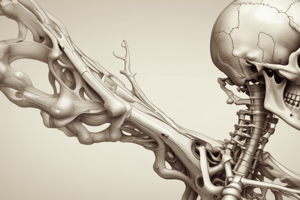Podcast
Questions and Answers
What is the hip joint referred to as?
What is the hip joint referred to as?
- Shoulder joint
- Knee joint
- Hip joint (correct)
- Elbow joint
Which of the following are types of nerves associated with the coxal region? (Select all that apply)
Which of the following are types of nerves associated with the coxal region? (Select all that apply)
- Femoral nerve (correct)
- Obturator nerve (correct)
- Radial nerve
- Sciatic nerve (correct)
Which of the following are bony structures found in the coxal region? (Select all that apply)
Which of the following are bony structures found in the coxal region? (Select all that apply)
- Body of ischium (correct)
- Head of femur (correct)
- Neck of femur (correct)
- Clavicle
Which of these are blood vessels related to the coxal region? (Select all that apply)
Which of these are blood vessels related to the coxal region? (Select all that apply)
Which muscles are involved in actions around the coxal region? (Select all that apply)
Which muscles are involved in actions around the coxal region? (Select all that apply)
What action does the gluteus medius muscle perform?
What action does the gluteus medius muscle perform?
Flashcards are hidden until you start studying
Study Notes
Coxal Region Study Notes
- Hip Joint: The primary joint structure in the coxal region, essential for movement and weight-bearing.
Nerves
- Femoral Nerve: Innervates the anterior compartment of the thigh, crucial for leg extension and sensation.
- Obturator Nerve: Responsible for innervating the medial compartment of the thigh, aiding in adduction.
- Sciatic Nerve: The largest nerve in the body, innervating the posterior compartment of the thigh and lower leg.
Bony Structures
- Head of Femur: Articulates with the acetabulum, forming the hip joint.
- Neck of Femur: Connects the head to the body, susceptible to fractures.
- Body of Ischium: Part of the pelvic bone, contributing to the acetabulum.
- Body of Pubis: Forms the anterior region of the pelvis, assisting in pelvic structure.
- Greater Sciatic Notch: A key landmark for the passage of nerves and blood vessels from the pelvis to the lower limb.
Blood Vessels
- External Iliac Vein: Drains blood from the lower limb back to the heart.
- Internal Iliac Vein: Collects blood from the pelvic region.
- Great Saphenous Vein: The longest vein in the body, important for superficial venous drainage.
- Femoral Artery: Main artery supplying blood to the lower limb.
- Deep Femoral Vein: Accompanies the deep femoral artery, critical for venous return.
Muscles and Actions
- Adductor Longus: Primarily functions to adduct and flex the thigh.
- Pectineus: Assists in thigh adduction and flexion; located in the upper thigh.
- Gracilis: A long, thin muscle that adducts and flexes the thigh.
- Gluteus Medius: Abducts and medially rotates the thigh, essential for stability when walking.
- Gluteus Minimus: Similar function to gluteus medius, contributing to thigh movement and stability.
Studying That Suits You
Use AI to generate personalized quizzes and flashcards to suit your learning preferences.




